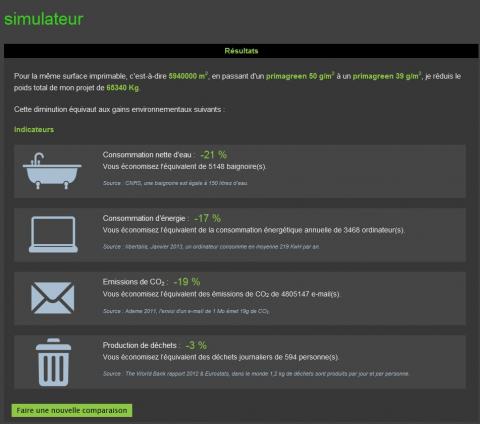Calculate the environmental impact of your print jobs online

The environmental impact simulator, a new step towards sustainable development
Bolloré Thin Papers has launched a simplified Internet version of its environmental impact simulator. It is accessible through the website www.bollorethinpapers.com and can be found in the new list titled Sustainibility which was reconfigured and updated this autumn. Bolloré Thin Papers offers answers to any questions and needs its users may have: therefore, a customer looking for information on Bolloré Thin Papers’ certifications or environmental policies will uncover the answers to their questions in just a few clicks. We have also published all the data on the societal responsibility of the company with a detailed presentation on our most recent partnerships and the first report on the biodiversity plan implemented this year by Bolloré Thin Papers.
Based on the results obtained through the Life Cycle Assessment, this simulator represents a real opportunity for users and an authentic tool to guide them in making a decision: it makes it possible for them to understand in a concrete and visual way the advantages of using thin paper and it will especially demonstrate that a decrease in the grammage of the paper may bring about a significant decrease in the impact it has on the environment.
A Very Simple Interface
Access to the simulator is possible though the menu Our expertise in the column Sustainable Development. Three alternatives are made available to users in order to determine their needs:
- Pagination, print jobs and formats expressed in cm,
- The surface for the print job in sq. metres,
- The tonnage expressed in kilograms.
A concrete Environmental Advantage
With just one click, the user will know the quality of paper that he or she needs in order to complete his or her project. He or she will then be able to compare, based on their choice of a certain type of paper, the environmental impact for both grammages.
In a very visual manner, the Internet user will be able to observe the environmental advantage that he or she is receiving in terms of:
- Water consumption, expressed in the amount of bathtubs of water
- Energy consumption, expressed in annual usage of energy in x amount of computers
- CO2 emissions, expressed in the amount of CO2 emissions caused by sending x amount of emails
- Waste production, expressed in the amount of daily waste from x amount of people.
For a complete report on the environmental impact of your project, you may consult with Julie Paccot who is in charge of marketing and sustainable development: j.paccot@pdl.fr.
